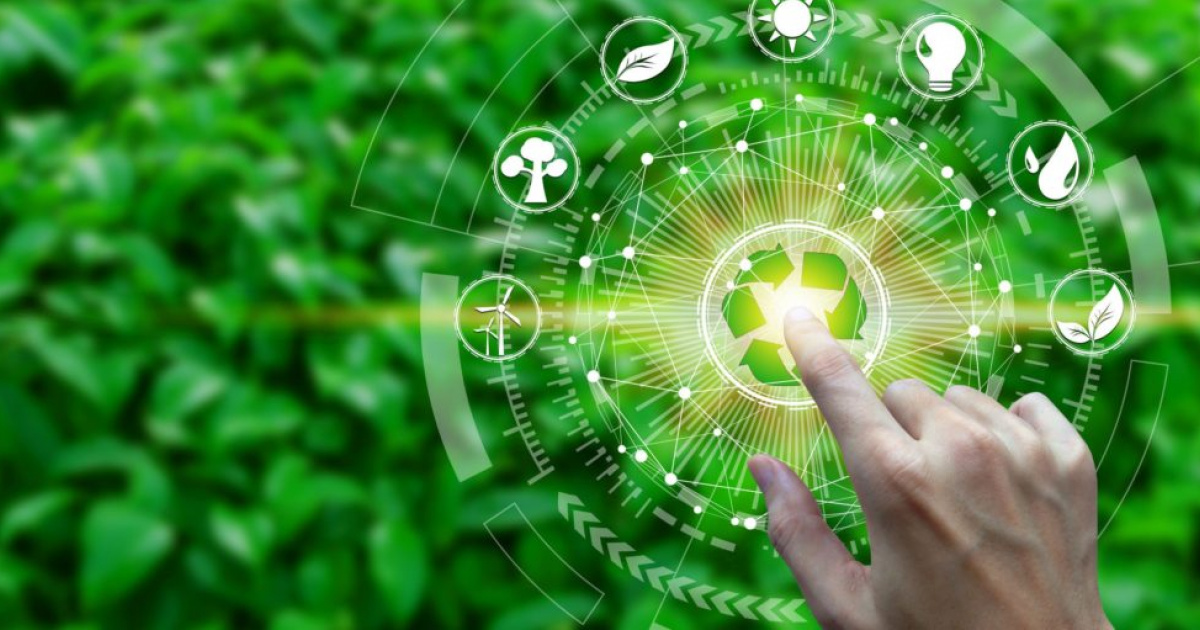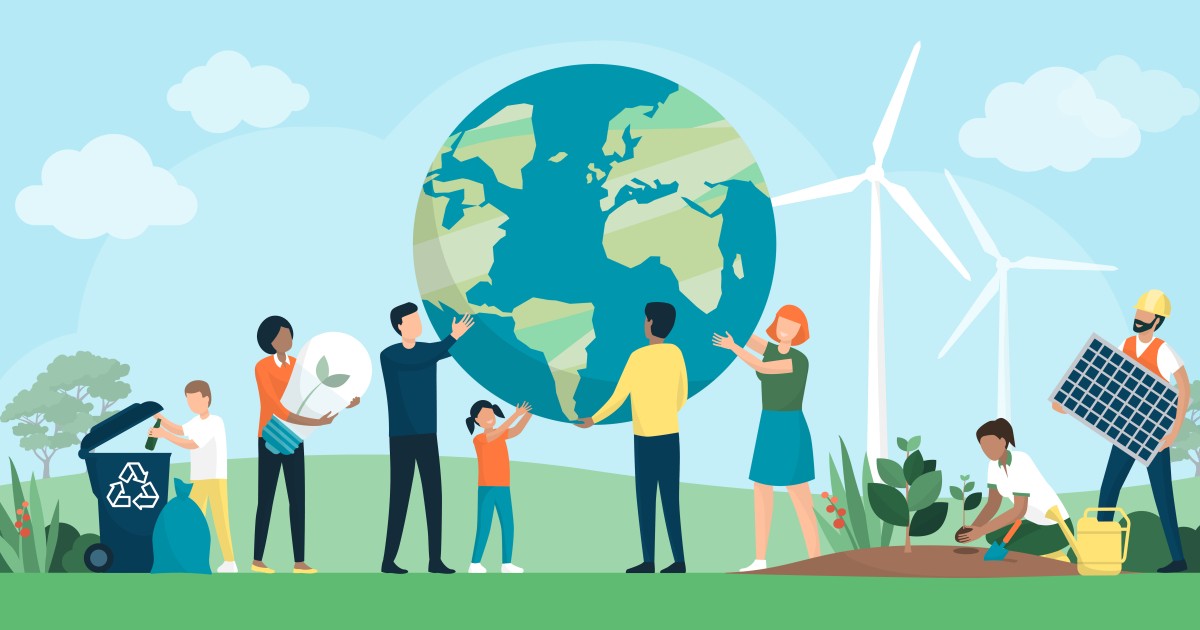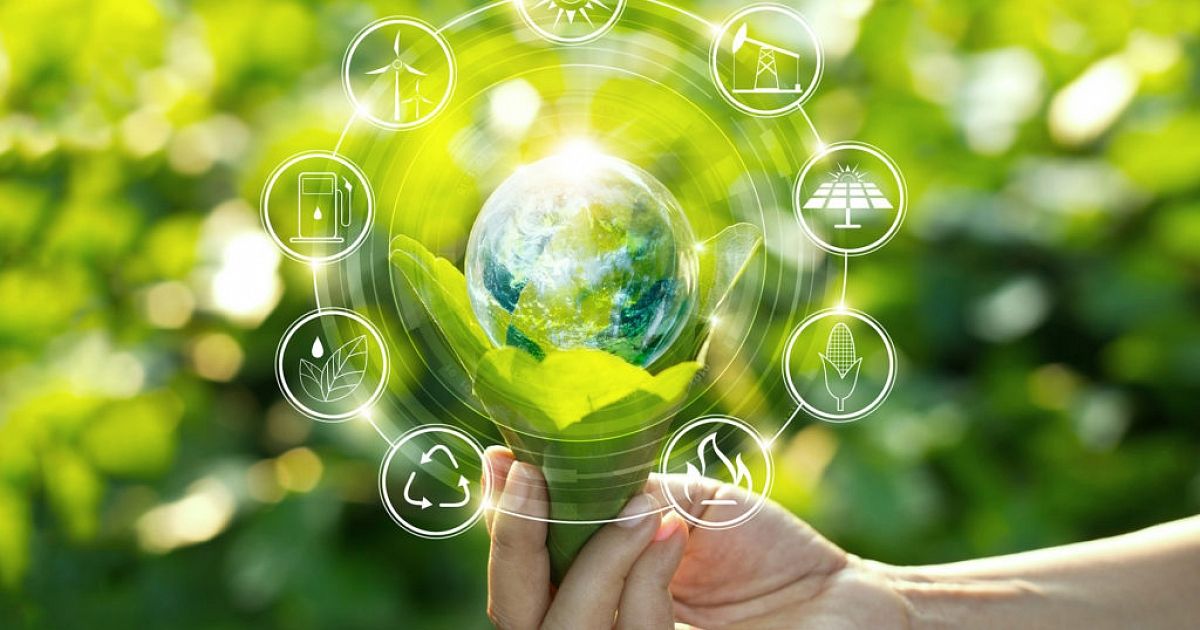Circular Economy in Tech: Redefining Sustainability and Waste Management
In the ever-evolving landscape of technology, the concept of a circular economy has emerged as a beacon of sustainable innovation. This introductory section aims to shed light on the essence of a circular economy, providing an insightful overview of how the tech industry’s growth has left an indelible mark on our environment, leading to an imperative need for sustainable practices.
Understanding the Circular Economy
To embark on this journey, it’s crucial to grasp the fundamentals of a circular economy. Unlike the linear model, where products follow a “take, make, dispose” trajectory, a circular economy focuses on regenerative systems, emphasizing the continuous use and recycling of resources.
Tech Industry’s Environmental Footprint
The tech industry, often celebrated for its advancements, has inadvertently contributed to environmental challenges. From resource extraction to electronic waste, the environmental impact is vast. This sets the stage for the urgency of adopting circular practices.
Call for Sustainability in Tech
Recognizing the impact of the linear economy, there is a growing call for sustainable practices within the tech sector. This chapter lays the foundation for the subsequent exploration into how circular economy principles can redefine the industry’s approach to sustainability and waste management.
The Linear Economy Challenge
As we delve into the challenges posed by the linear economy model, this chapter aims to provide a comprehensive understanding of its workings, environmental drawbacks, and the alarming rise in electronic waste.
Linear Economy Demystified
Unpacking the traditional linear economy model, we find a system that encourages resource depletion, excessive waste, and a linear progression from production to disposal.
Environmental Ramifications
A detailed discussion ensues on the environmental consequences inherent in the linear model, highlighting issues such as pollution, resource scarcity, and the irreversible damage caused to ecosystems.
E-Waste Explosion
Supported by compelling statistics and figures, we explore the surge in electronic waste, revealing the extent of the problem. The escalating quantities of discarded electronic devices underscore the urgency for a shift to a circular economy.
Enter the Circular Economy

This chapter serves as a gateway into the transformative realm of circular economy principles, elucidating its definition, core principles, and its stark contrast to the linear model.
Defining Circular Economy
Here, we define the circular economy and delve into its principles, emphasizing the regenerative approach that focuses on the continual use, refurbishment, and recycling of products.
Divergence from Linear Practices
Drawing a clear distinction between the linear and circular models, we highlight how the circular economy prioritizes sustainability, emphasizing the cyclical flow of materials and minimizing waste.
The 3 R’s in Tech
Putting theory into practice, this section accentuates the importance of reducing, reusing, and recycling in the tech industry. Examples and case studies showcase how these principles are being integrated into the fabric of tech manufacturing.
Tech Innovations Driving Circular Economy
In this segment, we explore the forefront of sustainable innovation within the tech industry, spotlighting eco-friendly materials, modular design, and companies that champion circular economy principles.
Eco-Friendly Materials
Embarking on a journey into sustainable tech materials, we uncover innovations ranging from bio-based plastics to recycled metals, showcasing the industry’s commitment to reducing its ecological footprint.
Modular Design Revolution
The role of modular design and upgradability takes center stage, illustrating how this approach enhances product lifespan, reduces electronic waste, and allows for easier recycling.
Case Studies in Circular Tech
Turning theory into practice, we delve into real-world examples, examining companies at the vanguard of circular economy implementation. Their success stories inspire a paradigm shift within the industry.
E-Waste Crisis

A sobering exploration awaits as we navigate the intricate web of the global e-waste crisis, unraveling its implications, associated health hazards, and the staggering scale of electronic waste generation.
Global E-Waste Landscape
A panoramic view of the e-waste crisis unfolds, taking into account the geographical and demographic dimensions. This section illuminates the alarming rate at which electronic waste is escalating globally.
Environmental and Health Impacts
The repercussions of improper e-waste disposal extend beyond environmental concerns, seeping into the health of ecosystems and human populations. We delve into these interlinked challenges to provide a comprehensive perspective.
Quantifying the Electronic Waste Mountain
Armed with statistics and insights, we present a comprehensive overview of the sheer volume of electronic waste generated worldwide, emphasizing the urgency for effective waste management strategies.
Extended Producer Responsibility (EPR)
Shifting focus to solutions, this chapter introduces the concept of Extended Producer Responsibility (EPR), examining its role, successful implementations globally, and its influence on manufacturers’ accountability.
Unpacking EPR
Extended Producer Responsibility is dissected, highlighting how it compels manufacturers to take a holistic approach, ensuring responsible management of products throughout their life cycle.
Global Pioneers in EPR
Drawing from international examples, we spotlight countries that have successfully implemented EPR programs. Their experiences serve as a blueprint for effective waste management and recycling.
Nurturing Product Lifecycle Responsibility
This section delves into how EPR acts as a catalyst, fostering a sense of responsibility among manufacturers to actively engage in sustainable practices, from design to disposal.
Eco-Design in Tech

With a focus on product design, this chapter explores the integration of eco-design principles in tech products, shedding light on sustainable packaging and the impact of consumer demand.
Sustainable Design Paradigms
The evolution of eco-design principles in tech becomes apparent, emphasizing the importance of considering environmental impact from the inception of product design.
Packaging Innovations
Zooming in on packaging, we explore sustainable alternatives and innovations that reduce the environmental footprint, from biodegradable materials to minimalist packaging approaches.
Consumer Influence on Design
Consumer demand has become a driving force in shaping sustainable tech practices. This section explores how environmentally conscious consumers are steering companies towards eco-friendly design choices.
Tech Recycling Processes
The journey into sustainable tech practices continues with an exploration of the intricacies of tech recycling processes, identifying challenges, advancements, and the pivotal role of responsible e-waste recycling facilities.
Dissecting Tech Recycling
We unravel the processes involved in recycling electronic devices, providing a detailed overview of how tech components are salvaged and repurposed.
Navigating Challenges
Acknowledging the hurdles in tech recycling, we discuss challenges such as material separation, toxicity concerns, and the need for advanced recycling technologies.
Advancements in Recycling Tech
Despite challenges, the tech industry is witnessing significant strides in recycling technologies. We highlight these innovations and their potential to reshape the landscape of electronic waste management.
Second Life for Electronics
Shifting the narrative to the afterlife of electronic devices, this chapter explores the rise of the refurbished electronics market, the benefits of extending product lifespan, and the consumer perspective on buying refurbished tech products.
Emergence of Refurbished Electronics
A discussion on the growing popularity of refurbished electronics sets the stage, underlining how consumers are embracing pre-owned devices as a sustainable choice.
Prolonging Product Lifespan
Benefits associated with extending the lifespan of electronic devices take center stage, emphasizing reduced e-waste, resource conservation, and economic advantages for consumers.
Consumer Trust in Refurbished Tech
Addressing consumer perceptions, we explore how the refurbished tech market is gaining trust, debunking myths and providing insights into why consumers are opting for sustainable alternatives.
Blockchain in Waste Management
In this innovative chapter, we delve into the intersection of blockchain technology and waste management, exploring its introduction, applications in tracking and managing e-waste, and its potential to foster transparency and accountability.
Introduction to Blockchain in Waste Management
The fundamentals of blockchain technology are demystified, laying the groundwork for its application in revolutionizing waste management practices.
Tracking and Managing E-Waste
We explore real-world use cases, showcasing how blockchain technology is utilized to track the journey of electronic waste, from collection to recycling, ensuring a transparent and traceable process.
Transparency and Accountability
Examining the potential for blockchain to bring transparency and accountability to waste management, we discuss its implications for reducing illegal dumping and unethical disposal practices.
Collaborative Initiatives

Collaboration takes the spotlight in this chapter as we explore partnerships and initiatives within the tech industry, emphasizing how collaborative efforts enhance circular economy practices through successful cross-industry endeavors.
Forging Partnerships
An exploration of collaborations within the tech industry unfolds, demonstrating how companies are coming together to share knowledge, resources, and strategies to promote sustainability.
Enhancing Circular Economy Practices
Highlighting the synergy created by collaborative initiatives, we discuss how these efforts contribute to the evolution of circular economy practices, fostering innovation and collective responsibility.
Success Stories in Collaboration
Case studies of successful cross-industry initiatives exemplify the positive outcomes that can arise when competitors, policymakers, and environmental organizations unite for a common cause.
Consumer Awareness and Education
This pivotal chapter explores the crucial role of consumer awareness in steering sustainable tech choices. We delve into the importance of educating consumers on the impact of e-waste and how informed choices influence industry practices.
Empowering Consumers
Recognizing the power of informed decisions, we discuss how raising consumer awareness empowers individuals to make choices aligned with sustainability goals, influencing market trends.
Impactful Education Initiatives
Highlighting successful education initiatives, we showcase programs that bridge the knowledge gap, enabling consumers to understand the consequences of their tech choices.
Influencing Industry Practices
An exploration into how informed consumers act as catalysts for change, prompting tech companies to prioritize sustainability in response to shifting consumer preferences.
Government Regulations
Governments play a pivotal role in shaping sustainable practices within the tech industry. This chapter provides an overview of existing and emerging regulations related to tech sustainability, their impact, and case studies of countries with successful regulatory frameworks.
Regulatory Landscape
Navigating the complex regulatory terrain, we provide insights into existing laws and emerging policies worldwide, designed to steer the tech industry towards sustainable practices.
Impact on Circular Economy Adoption
Analyzing the impact of government policies, we discuss how regulations influence the adoption of circular economy principles in the tech sector, driving companies to comply with environmentally friendly standards.
Case Studies in Regulatory Success
Examining countries with successful regulatory frameworks, we draw inspiration from their experiences, showcasing how government interventions can create an environment conducive to sustainable tech practices.
Challenges and Obstacles

Despite the commendable progress, challenges persist in the widespread adoption of circular economy practices. This chapter engages in a thoughtful discussion, addressing economic considerations, resistance from certain sectors, and proposing strategies to overcome obstacles and promote sustainability.
Hindrances to Adoption
A candid exploration of challenges hindering the broader adoption of circular economy practices, including economic constraints, technological barriers, and resistance from established industries.
Economic Considerations
Delving into the economic aspects, we discuss how circular economy adoption may face resistance due to perceived costs, and propose strategies to align sustainable practices with economic interests.
Strategies for Overcoming Obstacles
In response to identified challenges, we present proactive strategies and innovative solutions, encouraging a shift in mindset and fostering an environment conducive to circular economy practices.
Future Trends in Tech and Sustainability
Anticipating the future is a critical aspect of fostering sustainable practices. This chapter peers into the crystal ball, exploring anticipated technological advancements, the evolving landscape of sustainable practices in the tech industry, and the pivotal role of innovation in shaping the future of tech and sustainability.
Technological Advancements
An exploration of emerging technologies that are poised to reshape the tech industry, with a focus on those that align with circular economy principles, from advanced recycling methods to eco-friendly materials.
Evolution of Sustainable Practices
Charting the trajectory of sustainable practices, we discuss how the tech industry is expected to evolve, incorporating circular economy principles into its fabric and redefining traditional business models.
Innovation as a Driving Force
Emphasizing the symbiotic relationship between innovation and sustainability, we delve into how groundbreaking technologies will drive the next wave of sustainable practices in the tech sector.
Case Studies
In this illuminating chapter, we shine a spotlight on companies that have successfully implemented circular economy principles in their tech operations. Through in-depth case studies, we analyze the outcomes, impact on the environment, and extract valuable lessons that serve as inspiration for other companies to follow suit.
Showcasing Success
Case studies showcase companies that have embraced circular economy principles, highlighting their journey, the positive outcomes achieved, and the ripple effects on the environment.
Analyzing Environmental Impact
Diving into the environmental impact, we dissect how these companies have contributed to reducing their ecological footprint, emphasizing the tangible benefits of circular practices.
Inspiring Industry Transformation
The case studies act as beacons of inspiration, encouraging other tech companies to embark on a similar transformative journey, fostering a collective shift towards sustainability.
Global Impact of Circular Economy in Tech
Zooming out to a global perspective, this chapter examines the broader environmental and social impact of circular economy practices in the tech industry. We explore how tech companies can contribute to global sustainability goals and the interconnectedness of circular economy practices on a global scale.
Beyond Borders
Acknowledging the interconnected nature of the global ecosystem, we discuss how circular economy practices in the tech industry can transcend borders, impacting international sustainability efforts.
Tech Companies as Global Contributors
Highlighting the potential for tech companies to play a significant role in global sustainability goals, we explore how their adoption of circular practices can contribute to a more sustainable and interconnected world.
Collaborative Global Solutions
Drawing on the idea of a shared responsibility, we discuss the importance of collaborative efforts between nations, organizations, and individuals to address the global impact of tech-related environmental challenges.
Conclusion
As we reach the culmination of this insightful exploration, the conclusion chapter recaps the key points discussed throughout the blog post, issues a call to action for readers to support and advocate for circular economy practices in the tech industry, and offers closing thoughts on the transformative potential of sustainable tech practices.
Recap of Key Points
A succinct summary revisits the crucial concepts explored in the blog post, reinforcing the importance of circular economy principles in reshaping the tech industry.
Call to Action
Inspiring readers to be agents of change, we issue a call to action, urging them to actively support and advocate for circular economy practices, emphasizing the collective impact of individual choices.
Closing Thoughts
In a reflective tone, the conclusion chapter wraps up the narrative, offering closing thoughts on the transformative potential of sustainable tech practices. It leaves readers with a sense of optimism and empowerment, encouraging them to be catalysts for positive change in the ever-evolving world of technology and environmental sustainability.
Frequently Asked Questions (FAQ) – Circular Economy in Tech: Redefining Sustainability and Waste Management
What is a Circular Economy?
A circular economy is an economic model designed to minimize waste and make the most of resources. Unlike the traditional linear economy, which follows a “take, make, dispose” approach, a circular economy promotes a regenerative system, emphasizing the continuous use and recycling of resources.
How has the Tech Industry Impacted the Environment?
The tech industry’s growth has left a significant environmental footprint, contributing to issues such as resource depletion, pollution, and a surge in electronic waste. This FAQ delves into the challenges posed by the linear economy model and explores how the tech industry can embrace sustainability.
Why is Sustainable Practices Important in the Tech Sector?
Sustainable practices in the tech sector are crucial to address the environmental challenges posed by rapid technological advancements. This FAQ introduces the need for sustainable practices, setting the stage for an exploration into how circular economy principles can redefine the industry’s approach.
What are the Drawbacks of the Linear Economy Model?
The linear economy model encourages resource depletion, excessive waste, and poses environmental consequences. Stats and figures in this FAQ shed light on the increasing e-waste problem and the drawbacks associated with the traditional linear approach.
How Does a Circular Economy Differ from the Linear Model?
A circular economy differs from the linear model by prioritizing regenerative systems and focusing on reducing, reusing, and recycling. This FAQ provides insights into the principles that distinguish the circular economy from the traditional linear model.
What Innovations Drive Circular Economy in Tech?
Innovations such as eco-friendly materials, modular design, and upgradability play a pivotal role in driving the circular economy in the tech sector. This FAQ explores these innovations and showcases case studies of companies implementing circular economy principles.
What is the E-Waste Crisis?
The e-waste crisis refers to the growing global issue of electronic waste, posing environmental and health hazards. This FAQ provides an in-depth look at the scale of electronic waste generation and explores the challenges associated with improper disposal.
What is Extended Producer Responsibility (EPR)?
Extended Producer Responsibility (EPR) is a concept that holds manufacturers responsible for the entire life cycle of their products. This FAQ explains the significance of EPR, offers examples of successful programs globally, and details how it encourages manufacturers to take responsibility.
How is Eco-Design Integrated into Tech Products?
Eco-design principles involve integrating environmentally friendly practices into tech product design. This FAQ explores how eco-design contributes to sustainable packaging, reduced environmental impact, and how consumer demand influences companies to prioritize eco-friendly design.
What are the Challenges in Tech Recycling Processes?
Tech recycling processes face challenges such as material separation and toxicity concerns. This FAQ provides an overview of the recycling processes for electronic devices, highlights advancements, and underscores the importance of responsible e-waste recycling facilities.
What is the Second Life for Electronics?
The second life for electronics refers to the rise of the refurbished electronics market. This FAQ explores the benefits of extending the lifespan of electronic devices and offers insights into the consumer perspective on buying refurbished tech products.
How is Blockchain Used in Waste Management?
Blockchain technology is introduced to waste management, showcasing its use cases in tracking and managing e-waste. This FAQ discusses its potential for transparency and accountability in recycling processes.
How do Collaborative Initiatives Enhance Circular Economy Practices?
Collaborative initiatives within the tech industry enhance circular economy practices. This FAQ explores partnerships, knowledge-sharing, and successful cross-industry initiatives that contribute to sustainability.
What Role Does Consumer Awareness Play in Sustainable Tech Choices?
Consumer awareness is pivotal in driving sustainable tech choices. This FAQ delves into the role of informed consumers, the importance of educating them on e-waste impact, and how consumer choices influence industry practices.
How Do Government Regulations Impact Tech Sustainability?
Government regulations play a crucial role in shaping tech sustainability. This FAQ provides an overview of existing and emerging regulations, their impact on circular economy adoption, and case studies of countries with successful regulatory frameworks.
What Challenges Hinder Circular Economy Adoption?
Challenges hindering the widespread adoption of circular economy practices are explored in this FAQ. Economic considerations, resistance from certain sectors, and strategies to overcome obstacles are discussed.
What are the Future Trends in Tech and Sustainability?
Anticipated technological advancements, the evolution of sustainable practices in the tech industry, and the role of innovation in shaping the future are discussed in this FAQ.
How Do Circular Economy Practices Impact the Global Environment?
This FAQ examines the broader environmental and social impact of circular economy practices in the tech industry. It explores how tech companies can contribute to global sustainability goals and the interconnectedness of circular economy practices on a global scale.
What are Some Successful Circular Economy Implementations in Tech Companies?
Successful circular economy implementations in tech companies are showcased in this FAQ. Case studies analyze the outcomes, impact on the environment, and provide inspiration for other companies to follow suit.
How Can Readers Support Circular Economy Practices in the Tech Industry?
The FAQ concludes with a call to action, urging readers to actively support and advocate for circular economy practices in the tech industry. It emphasizes the transformative potential of sustainable tech practices and encourages readers to be catalysts for positive change.
Stay Tuned On Our Content
Dear Readers,
In our continuous journey towards unraveling the depths of sustainability and technological innovation, we invite you to delve deeper into the realm of eco-conscious living. Explore the internal link, Eco-Tech Living: Practical Steps for a Greener Lifestyle at Home, to discover practical steps for infusing a greener essence into your daily life. This insightful post not only provides actionable tips but also serves as a companion in your quest for a more sustainable and eco-friendly lifestyle.
For those hungry for a broader understanding of the circular economy, we recommend venturing beyond our digital pages. Check out the external link, The Circular Economy: Redefining Waste as a Resource, for a thought-provoking exploration of how waste can be transformed into a valuable resource. Gain fresh perspectives on circular practices and witness how others are contributing to reshaping the future of sustainability.
As we continue to curate content that sparks curiosity and inspires positive change, we encourage you to stay tuned, explore, and embrace the knowledge that empowers you to make a meaningful impact on the world.
Best Regards,
Leep Team
[email protected]




2 Responses